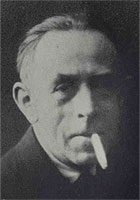
en

Paul Beyer was born in Strasbourg on November 9, 1873. His father had a significant stained glass factory there, but shortly after Paul's birth, his 78th child, the family moved to Besançon. They faced various difficulties, and his father died in hardship.
His widow continued to manage the factory, and that's how Paul Beyer first learned about the art of stained glass and eventually took over the family workshop. In 1904, the Separation of Church and State ruined him financially, causing him to abandon stained glass and dedicate himself to ceramics. He was enlisted in the war of 1914, but due to illness, he was released in 1917. Beyer joined his wife and two children in Lyon and participated in exhibitions before settling in Paris. From 1928, he exhibited at the Salons des Artistes Décorateurs and d'Automne and took part in various exhibitions in France and abroad, where he received prizes and awards.
Following the 1937 Exhibition, he was awarded the Knight of the Legion of Honor. In late 1931, the Sèvres Manufacture offered Beyer a workshop, and in 1932, they provided him with the "Vieux Moulin," the former studio of Henry Cross, where he stayed for about ten years. Some of Beyer's works were acquired by the state and are displayed at the Museum of Modern Art and the Ceramic Museum of Sèvres. In 1940, Beyer refused to leave Paris, and it was only in 1943 that his friends, particularly P.-L. Duchartre, convinced him to take refuge in La Borne, where a workshop was reserved for him.
Beyer worked there until the very limits of his strength and passed away in Bourges on September 10, 1945. Beyer took pride in being a potter. He embraced this role with conviction and joy when he rediscovered the old rural technique of salt-fired stoneware. A secret and profound harmony, like a passion, emerged between the man, the clay, his wheel, and the fire. He loved the rustic strength of high-temperature salt-fired stoneware, in contact with the flame, with its austere and pure nudity, barely veiled by the effects of sea salt and fire.
In Lyon, then at the Vieux Moulin, and finally in La Borne, among artisans faithful to stoneware, he crafted his forms on the potter's wheel. Beyer would start with one or several pots and assemble them, shaping them by hand. While he preferred utilitarian objects with logical forms shaped by their function, such as jugs, plates, and bowls, he also created a lively and humorous bestiary.
"I don't work," he would say, "I have fun."
Perhaps, fortified by the healthy and serene joy of a skilled artisan, he also had fun when sculpting the Virgin Mary, saints, or holy figures. There was the charming little Saint Barbara with her tiny tower, Saint Bon, the patron saint of potters, Saint Nicholas with children in a salting tub, Saint Francis with birds, and his admirable Saint Isidore, the patron saint of harvesters. This simple peasant, firmly anchored to the ground with broad, solid feet, embracing a sheaf of wheat with open arms.
In this way, Beyer revived the tradition of image makers who, at crossroads and village churches, created realistic and touching effigies of local saints.
Despite the rusticity of the material and their anachronism, Beyer's statues are akin to popular art and have already taken their place among the authentic masterpieces of ceramics.